BACK TO LESSON PLANS
Quilts as Inspiration for Apparel Design
Key Words: apparel design, quilted garments
Time Required: Variable, based on amount of time taken for conceptualizing and practicing techniques. At least 20 hours, including time for gathering materials, looking for design ideas, and completing the construction. Skill level will influence time required.
Learning Statement:
Quilts are usually thought of as two-dimensional objects. They are generally constructed for warmth and were made for bedcovers in early America. However, in the 18th century we begin to see quilted garments that were not only utilitarian, but began to be used in fashionable dress. Quilted petticoats, for example, were designed to be visible at the front of a fashionable dress. Perhaps the earliest example of a quilted garment is the 14th century pourpoint (or jacket) that was padded to protect the wearer from the newly-developed plate armor of that period. Now haute couture designers such as Christian Lacroix use traditional patchwork quilts to inspire modern fashion.
The purpose of this project is to design a quilted garment that uses the concept of quilting in a creative way.
The objectives are:
Connecting to the Quilt Index:
As a guide to conceptualization, think of the possible garments that could be quilted; how might the basic components of a quilt be varied to develop a creative outcome? Explore types of quilts and traditional versus contemporary patterns. To get ideas go to the Quilt Index website.
Go to the “BROWSE” button, and then search under “STYLE/TECHNIQUE.”
To find quilted garments in the Index use the following:
http://www.quiltindex.org/search_results.php?keywords=quilted+garment&search=go
Grade Level:
Post-secondary
Graduate/Research
Adult and Continuing Ed.
Guild Presentation
Content Areas: Arts, textiles
Materials:
Prerequisites for Learning:
Examples of quilted Garments:
“Kelley” has kept her garment simple by making a quilted collar that can be worn over different dresses.
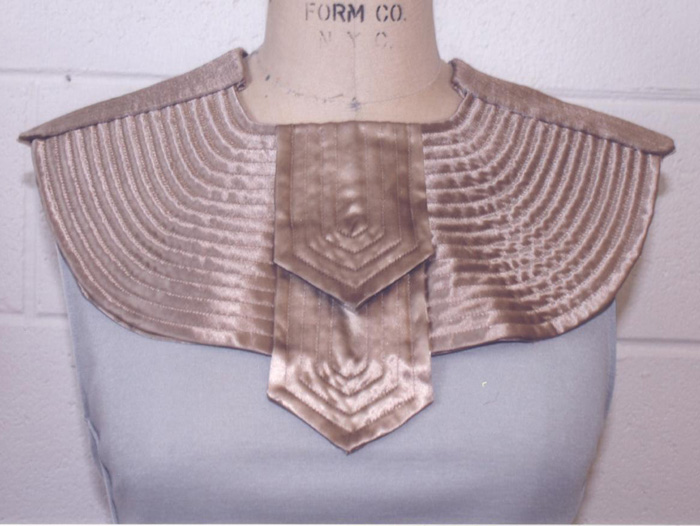
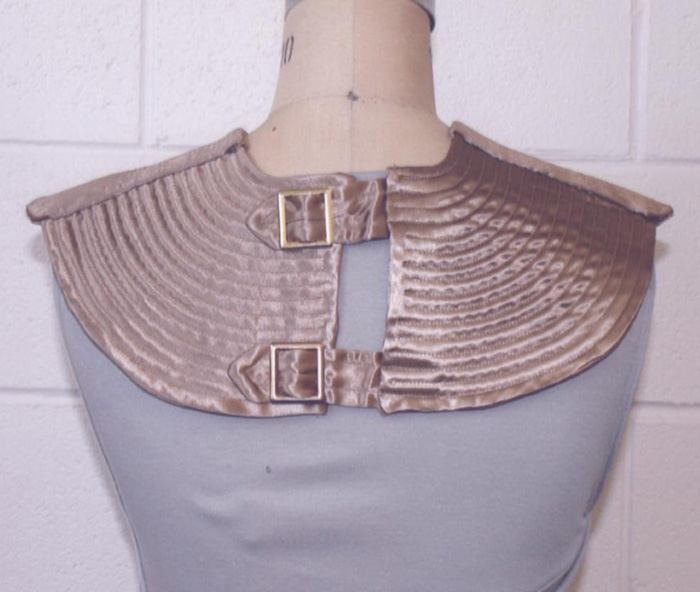
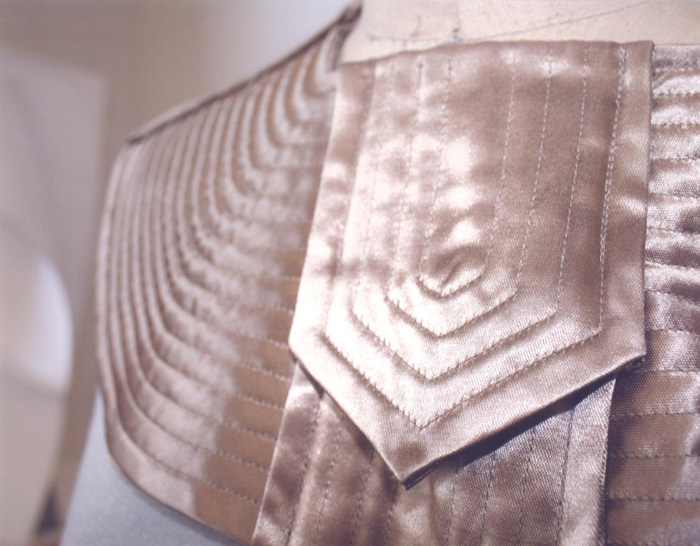 “Gabby” has used two types of quilting to complete her dress design.
“Gabby” has used two types of quilting to complete her dress design.
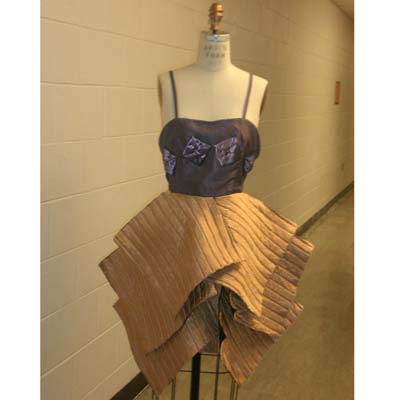 Pre-Lesson Activities for Students to Complete at Home:
Pre-Lesson Activities for Students to Complete at Home:
Think of the possible ways in which you can vary the components of a quilt to create the unexpected. Practice techniques by making a 10” X 10” square (or larger). Doing this helps to perfect your skill and decide if a technique is the look you want. Also, making a sample can help you determine if the materials selected work well together. For example “Nick” thought of using faux fur as his quilt top to create a unique look.
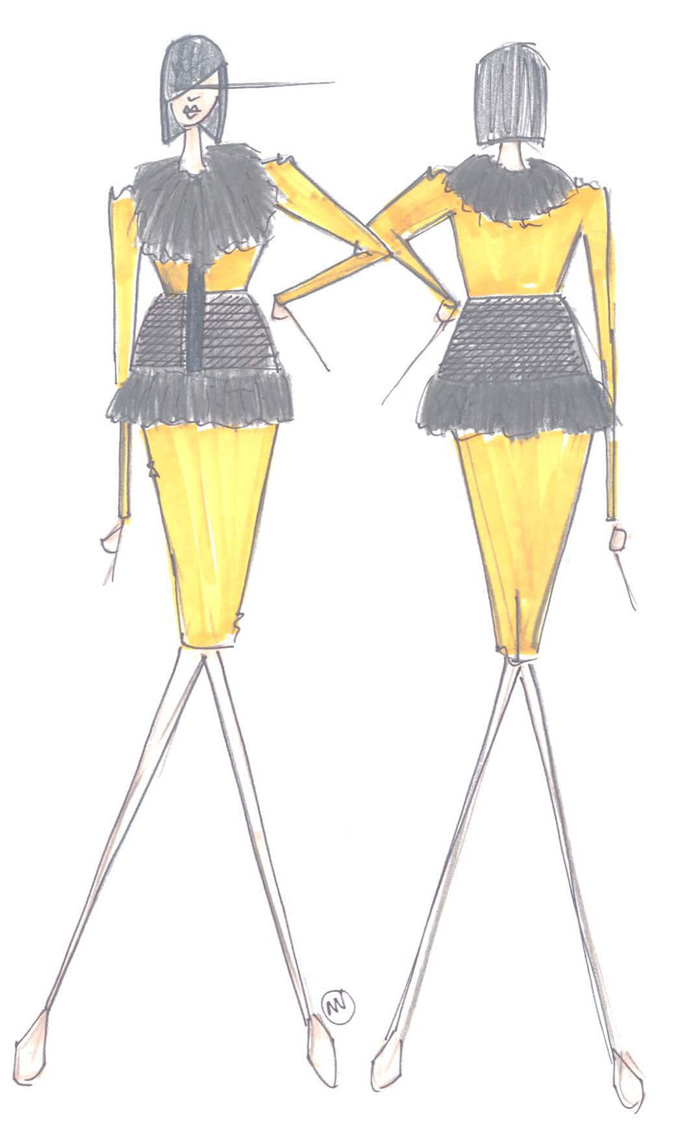
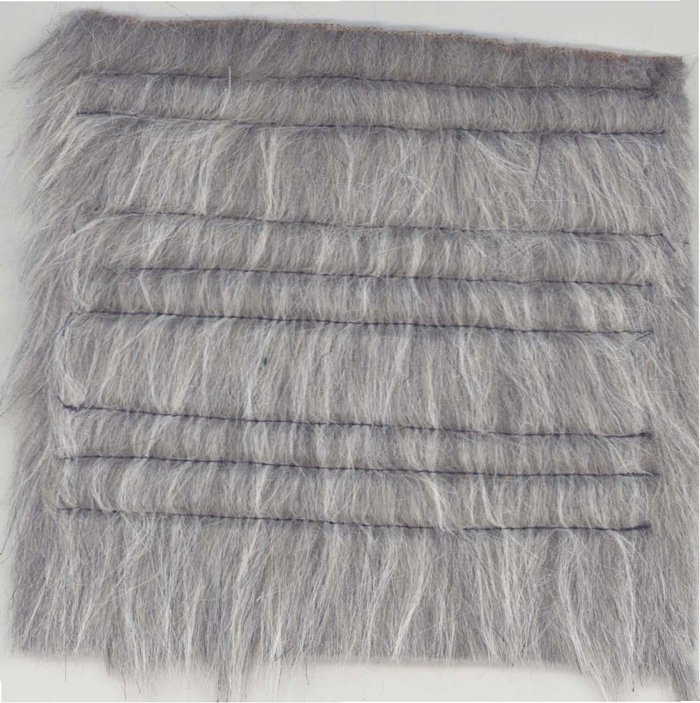
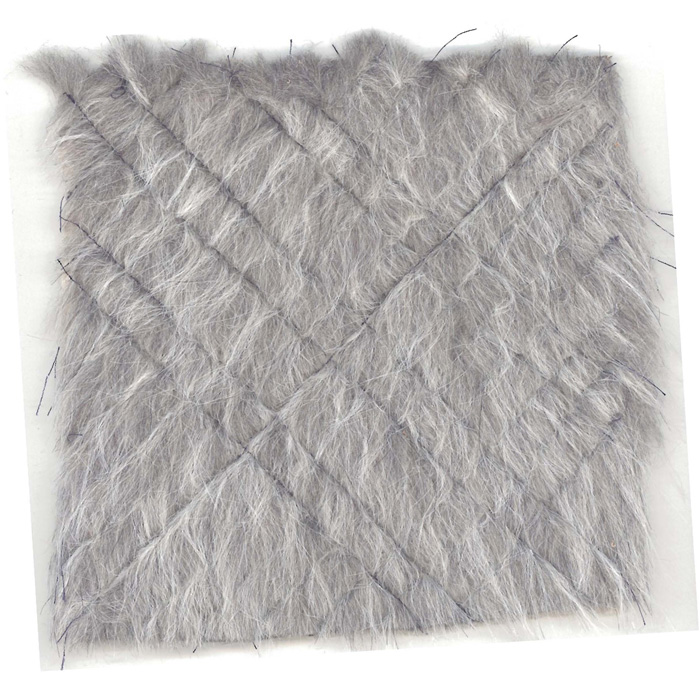 We don’t often think of using sheer fabrics in quilts; however, “Lauren” used the idea of layering sheer fabrics so that the colors were allowed to show through.
We don’t often think of using sheer fabrics in quilts; however, “Lauren” used the idea of layering sheer fabrics so that the colors were allowed to show through.
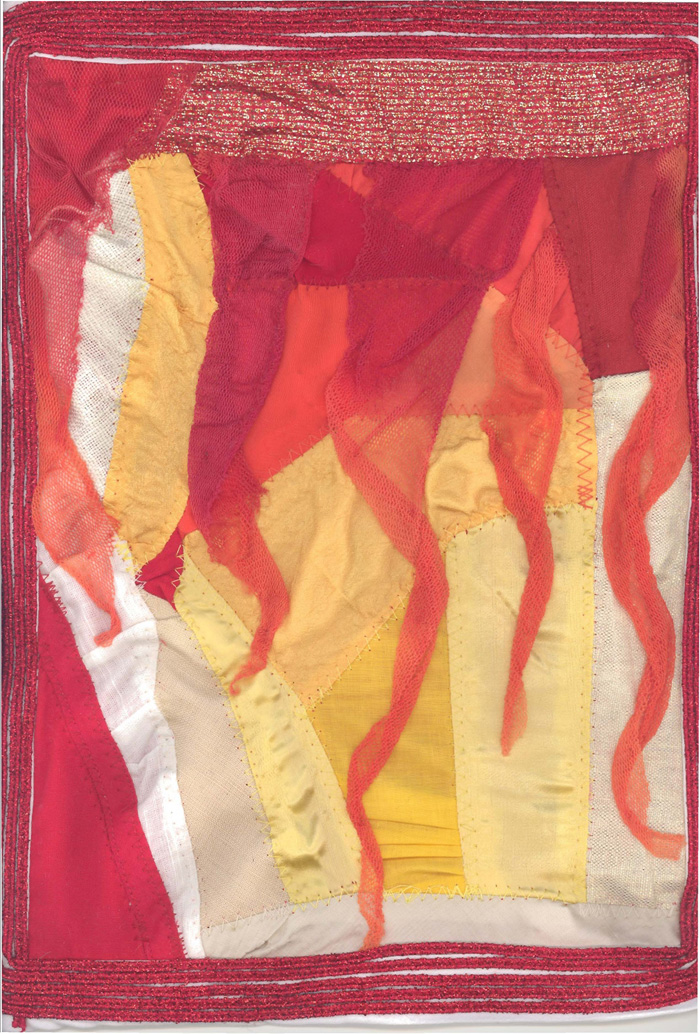
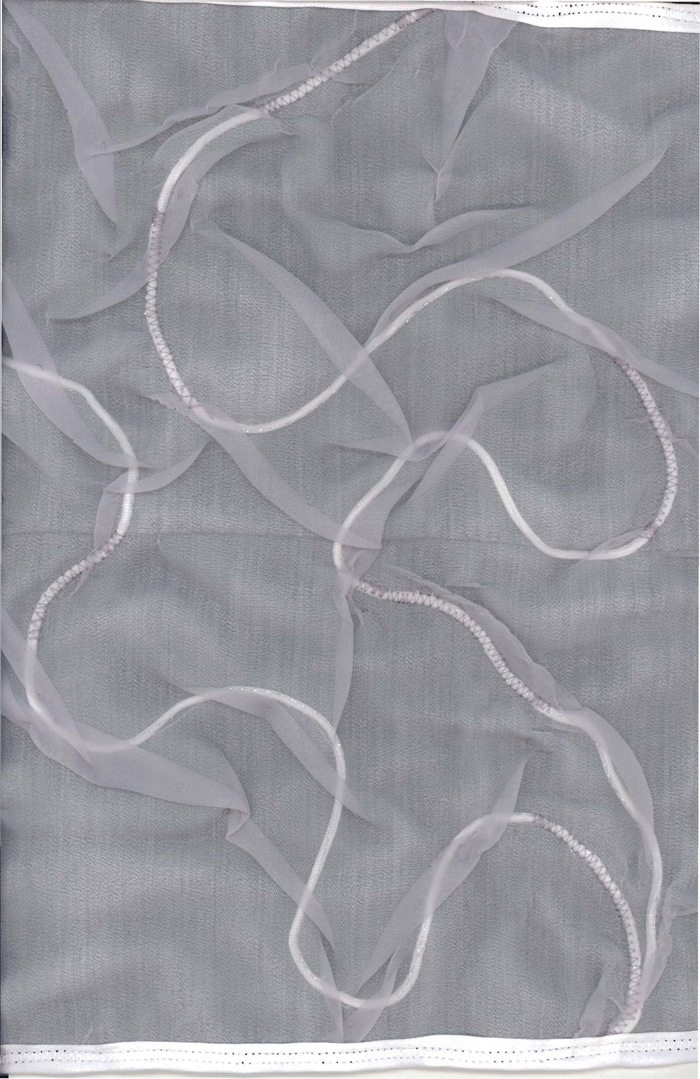 Another idea: the interlining, or middle layer of the quilt is typically used for warmth; however if sheer fabric is used for both the top and the backing, visually interesting materials can become visible through the sheer fabric.
Another idea: the interlining, or middle layer of the quilt is typically used for warmth; however if sheer fabric is used for both the top and the backing, visually interesting materials can become visible through the sheer fabric.
Process: Assembling the quilted garment requires
Remember that as you go through the quilting phase, the fabric will shrink. This could affect the size of your garment, so it may be helpful to cut out the pattern pieces after the quilting is done or to leave extra-wide seam allowances. Also, be aware that the combination of materials may make the garment stiffer or not as drapable. For an excellent example of channel-quilted garments see Threads Magazine, March 2010.
Post-Lesson Activities for Students to Complete at Home:
Investigate and experiment. Read, observe, and look at fabrics and other materials. A large variety of techniques for quilting and creating garments exists—or consider inventing your own techniques.
Follow-Up Activities:
Group members may want to join together to critique each others’ work. The Critique Group, well chosen and organized, can provide the members with invaluable exposure to fresh insights and new ways of looking at and growing their work over a period of time. In a critique group, artists present their work for comparison to a standard of excellence that is either chosen by the group or aspired to by individuals in the group. Works are not shown just to be admired; comments made are both positive and negative and, in the best of situations, delivered in the spirit of constructive advice for improving the work. In a good critique group, each member is met on his or her level, is treated seriously, spoken to with respect, given thoughtful responses to the work shown, and encouraged to stretch, grow, and see the work in new ways.
Group members may want to comment on the following:
Links and Additional Resources:
Jee Hyoung Jang is an example of a designer who uses new forms in architecture in relation to the human body with references to space, volume and movement as inspiration. Her quilted designs are inspired by Toyo Ito’s architecture. She was born and raised in Daegu, South Korea. See her work here.
Bibliography:
Baumgarten, Linda. “The Layered Look: Design in Eighteenth Century Petticoats.” DRESS 34 (2007): 7-31.
Masopust, Katie Pasquini. Design Explorations for the Creative Quilter. Lafayette, CA: C&T Publishing, 2008.
Mauries, Patrick, Saillard Olivier, and Christian Lacroix. Christian Lacroix: On Fashion. New York: Thames and Hudson, 1992.
Orlofsky, Patsy and Myron Orlofsky. Quilts in America. New York: Abbeville Press, 1992.
See magazines such as Threads and Quilting Arts for design ideas and step-by-step guides to certain techniques.
Glossary of Quilt-Related Terms:
Time Required: Variable, based on amount of time taken for conceptualizing and practicing techniques. At least 20 hours, including time for gathering materials, looking for design ideas, and completing the construction. Skill level will influence time required.
Learning Statement:
Quilts are usually thought of as two-dimensional objects. They are generally constructed for warmth and were made for bedcovers in early America. However, in the 18th century we begin to see quilted garments that were not only utilitarian, but began to be used in fashionable dress. Quilted petticoats, for example, were designed to be visible at the front of a fashionable dress. Perhaps the earliest example of a quilted garment is the 14th century pourpoint (or jacket) that was padded to protect the wearer from the newly-developed plate armor of that period. Now haute couture designers such as Christian Lacroix use traditional patchwork quilts to inspire modern fashion.
The purpose of this project is to design a quilted garment that uses the concept of quilting in a creative way.
The objectives are:
• to use historic quilt techniques as a source of creative inspiration.
• to practice at least one quilt technique.
• to expand the definition of “quilt” to move the concept into a three-dimensional aesthetic garment design.
• to design and execute a creative quilted garment.
Connecting to the Quilt Index:
As a guide to conceptualization, think of the possible garments that could be quilted; how might the basic components of a quilt be varied to develop a creative outcome? Explore types of quilts and traditional versus contemporary patterns. To get ideas go to the Quilt Index website.
Go to the “BROWSE” button, and then search under “STYLE/TECHNIQUE.”
To find quilted garments in the Index use the following:
http://www.quiltindex.org/search_results.php?keywords=quilted+garment&search=go
Grade Level:
Post-secondary
Graduate/Research
Adult and Continuing Ed.
Guild Presentation
Content Areas: Arts, textiles
Materials:
• End-use fabric suitable to the creator’s design aesthetic (this could vary from one yard for a vest to three yards or more for a dress)
• Interlining sufficient for the size of the garment or quilted sections within the garment
• Backing fabric sufficient for the size of the garment (note that backing fabric may not be needed depending on the style of the garment. It also can serve as a lining for the garment).
• Edging material, binding, or decorative border, depending on the designer’s concept for finishing edges
• Thread, buttons, and other notions
• Sewing machine, needles, scissors, materials for marking the quilting lines, and other sewing equipment
Prerequisites for Learning:
• Basic operation of the sewing machine.
• Previous garment construction skills are helpful.
• Knowing how to work with a commercial garment pattern is important. This reduces the amount of skill required to develop a pattern on your own. Using simple garments at first (vest, simple jacket, quilted accessory such as a belt) makes the process go more smoothly and can make fitting the garment easier. You may also limit quilted areas to certain segments of the garment such as a yoke or collar.
• Simple sketching techniques can be used to experiment with garment ideas.
Examples of quilted Garments:
“Kelley” has kept her garment simple by making a quilted collar that can be worn over different dresses.

Kelly's Quilted Collar, front

Kelly's Quilted Collar, back

Kelly's Quilted Collar, detail
Gabby's Dress
Think of the possible ways in which you can vary the components of a quilt to create the unexpected. Practice techniques by making a 10” X 10” square (or larger). Doing this helps to perfect your skill and decide if a technique is the look you want. Also, making a sample can help you determine if the materials selected work well together. For example “Nick” thought of using faux fur as his quilt top to create a unique look.

Nick's faux fur sketch

Nick's faux fur

Nick's faux fur
Lauren's sheer fabric

Lauren's sheer fabric
Process: Assembling the quilted garment requires
• Conceptualizing the type of garment that you will make and coordinating the construction of the quilted fabric to complement and reinforce the design of the garment
• Gathering the appropriate materials
• Design and construction of the top
• Assembling the three layers (top, interlining, backing)
• Quilting (stitching or tying) the layers together
• Assembling the garment
• Applying a border or edge finish
Remember that as you go through the quilting phase, the fabric will shrink. This could affect the size of your garment, so it may be helpful to cut out the pattern pieces after the quilting is done or to leave extra-wide seam allowances. Also, be aware that the combination of materials may make the garment stiffer or not as drapable. For an excellent example of channel-quilted garments see Threads Magazine, March 2010.
Post-Lesson Activities for Students to Complete at Home:
Investigate and experiment. Read, observe, and look at fabrics and other materials. A large variety of techniques for quilting and creating garments exists—or consider inventing your own techniques.
Follow-Up Activities:
Group members may want to join together to critique each others’ work. The Critique Group, well chosen and organized, can provide the members with invaluable exposure to fresh insights and new ways of looking at and growing their work over a period of time. In a critique group, artists present their work for comparison to a standard of excellence that is either chosen by the group or aspired to by individuals in the group. Works are not shown just to be admired; comments made are both positive and negative and, in the best of situations, delivered in the spirit of constructive advice for improving the work. In a good critique group, each member is met on his or her level, is treated seriously, spoken to with respect, given thoughtful responses to the work shown, and encouraged to stretch, grow, and see the work in new ways.
Group members may want to comment on the following:
• Technical Expertise: ability to use the techniques inherent in and important to the medium.
• Craft: ability to manipulate the materials with skill and finesse. Does the fabric and/or other materials blend well with and contribute to the composition of the piece?
• Innovation & Invention: ability to create new forms, develop new ideas, and “think outside the box.” What elements do you consider unique in the design?
• Idea Development: ability to generate multiple alternative ways to give form to an idea, and persistence to work beyond obvious solutions to unique interpretations.
• Composition: ability to use compositional elements and principles to achieve expressive goals. Describe the “customer” who might select this design. What words might be used to describe the personality of the piece (conservative, youthful, business-like, quirky). Describe an occasion that might be appropriate for the wearing of this garment.
• Attention to detail: the ability to focus on and resolve all of the details that “finish” a design and make it presentable for public view. Does construction affect the overall appearance of the piece in a positive or negative way?
• Experimentation: ability to play with new ideas and extend one’s visual vocabulary by answering the question, “what if?”
• Taking risks with new directions: ability or willingness to depart from the safety of past successes and try something new. Be constructive with suggestions and observations. Give the kind of information you would like to receive about your own work.
Links and Additional Resources:
Jee Hyoung Jang is an example of a designer who uses new forms in architecture in relation to the human body with references to space, volume and movement as inspiration. Her quilted designs are inspired by Toyo Ito’s architecture. She was born and raised in Daegu, South Korea. See her work here.
Bibliography:
Baumgarten, Linda. “The Layered Look: Design in Eighteenth Century Petticoats.” DRESS 34 (2007): 7-31.
Masopust, Katie Pasquini. Design Explorations for the Creative Quilter. Lafayette, CA: C&T Publishing, 2008.
Mauries, Patrick, Saillard Olivier, and Christian Lacroix. Christian Lacroix: On Fashion. New York: Thames and Hudson, 1992.
Orlofsky, Patsy and Myron Orlofsky. Quilts in America. New York: Abbeville Press, 1992.
See magazines such as Threads and Quilting Arts for design ideas and step-by-step guides to certain techniques.
Glossary of Quilt-Related Terms:
Top, the main aesthetic element in the quilt
Interlining (or bat) which provides the insulation
Backing, the last layer in the assembly that protects the interlining from wear
Piecing or piece work is the process of seaming small bits of fabric together to form an overall sheet. These small bits of fabric have historically been pieces of leftover fabric. Pieced quilts may be composed of odd-shaped bits of fabric or geometric forms like squares, triangles and rectangles.
Appliqué is the process of sewing small pieces of fabric onto a background fabric. For a more three-dimensional effect, the textile artist could add extra wool or cotton to the underside of the appliqué before hemming it down to the background fabric.
Quilting, or the lines of stitching that hold the sandwich together, adds another element into the design of a quilt. In addition to preventing the layers from shifting, the stitching pattern has to be developed to complement the top design and the function of the quilt. This typically consists of simple grids, parallel rows of stitching as well as intricate floral motifs.
Channel quilting is also known as “echo” or “contour” quilting. Using this technique will produce parallel rows of stitching that can add texture and shadow to the surface of your garment.
-
Museum
Michigan State University Museum Michigan Quilt Project
Load More